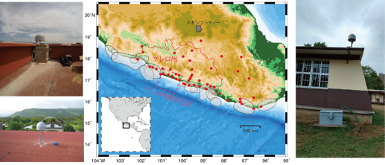News
Associate Professor Yoshihiro Ito, Associate Professor Takuya Nishimura, Disaster Prevention Research Institute, Kyoto University and their colleagues in National Autonomous University of Mexico, University of Rhode Island, and University of California, Santa Cruz, analyzed crustal deformation from GNSS stations in Mexico, as an international collaborative research project to identify slip distribution of slow slip events and interpolate coupling on the plate interface between Cocos and North America plates. As a result, it was clarified that an interaction among three large earthquakes with magnitude larger than 7 and slow slip events occurred in Mexico from 2017 to 2019. Slow slip events sometimes trigger a large earthquake, and a large earthquake conversely triggers slow slip. These triggering of large earthquakes by the slow slip events and those of slow slip by large earthquakes have been individually reported in several regions. There have been, however, few studies that have investigated the interaction among some of the large earthquakes and slow slip events in detail.
Part of this international collaborative research between Japan and Mexico was supported by JST and JICA with SATREP "Integrated Research for Mitigating Mega-Earthquake and Tsunami Hazards in Coastal Mexico" (PIs: Y. Ito, Kyoto University and V.M. Cruz-Atienza, UNAM).
These results were published in Nature Communications on 12 April 2021.
Abstract of the Article:
"Either the triggering of large earthquakes on a fault hosting aseismic slip or the triggering of slow slip events (SSE) by passing seismic waves involve seismological questions with important hazard implications. Just a few observations plausibly suggest that such interactions actually happen in nature. In this study we show that three recent devastating earthquakes in Mexico are likely related to SSEs, describing a cascade of events interacting with each other on a regional scale via quasi-static and/or dynamic perturbations across the states of Guerrero and Oaxaca. Such interaction seems to be conditioned by the transient memory of Earth materials subject to the "traumatic" stress produced by seismic waves of the great 2017 (Mw8.2) Tehuantepec earthquake, which strongly disturbed the SSE cycles over a 650 km long segment of the subduction plate interface. Our results imply that seismic hazard in large populated areas is a short-term evolving function of seismotectonic processes that are often observable."







